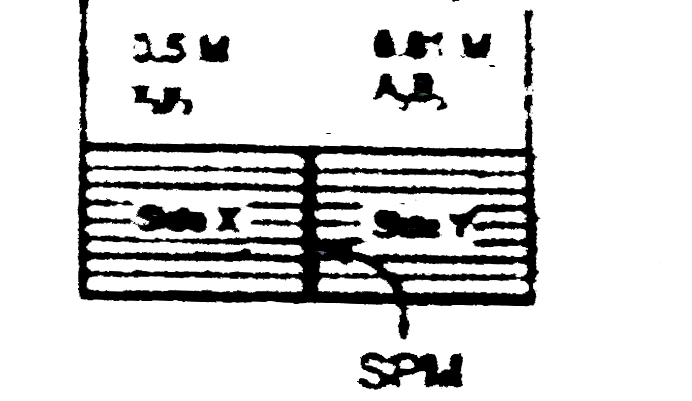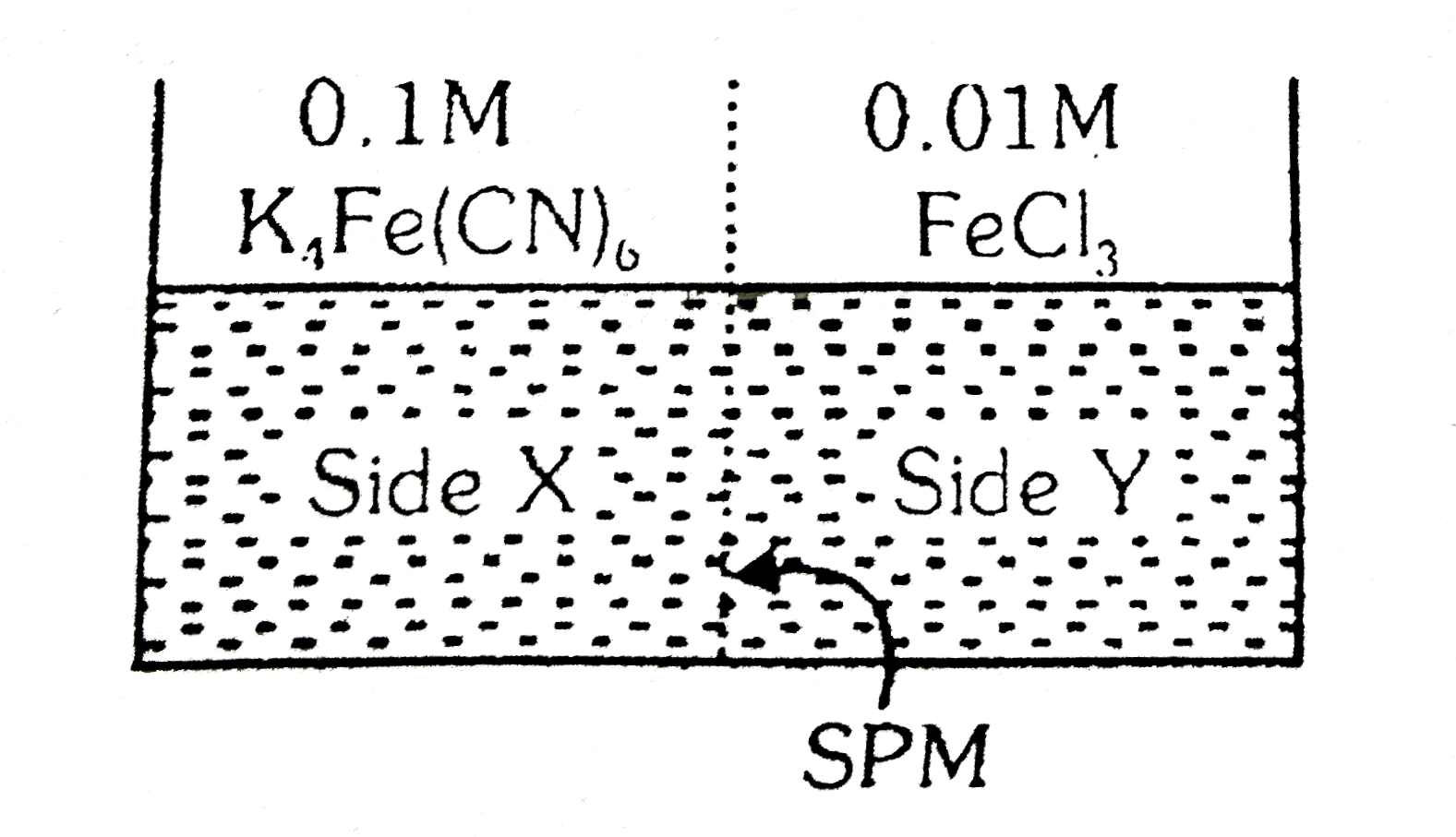X3Y2(i=5) when reacted with A2B3(i=5 in aqueous solution gives brown colour. These are separated by a semipermeable membrane AB as shown. Due to oxmosis there is :
 Solution in Telugu
Solution in Telugu
brown colour formation in side X
brown colour formation in side Y
formation in both of the sides X and Y
no brown colour formation
The correct Answer is:d
Step by step video & image solution for X_(3)Y_(2)(i=5) when reacted with A_(2)B_(3)(i=5 in aqueous solution gives brown colour. These are separated by a semipermeable membrane AB as shown. Due to oxmosis there is : by Chemistry experts to help you in doubts & scoring excellent marks in Class 11 exams.
Topper's Solved these Questions
- BOOK - NARENDRA AWASTHICHAPTER - DILUTE SOLUTIONEXERCISE - Level 21videos
DILUTE SOLUTION
- BOOK - NARENDRA AWASTHICHAPTER - DILUTE SOLUTIONEXERCISE - Level 3 - Match The Column1videos
DILUTE SOLUTION
- BOOK - NARENDRA AWASTHICHAPTER - CHEMICAL EQUILIBRIUMEXERCISE - Level 21videos
CHEMICAL EQUILIBRIUM
- BOOK - NARENDRA AWASTHICHAPTER - ELECTROCHEMISTRYEXERCISE - Level 3 - Subjective Problems1videos
ELECTROCHEMISTRY
Similar Questions
A saturated solution of XCl3 has a vapour pressure 17.20 mm Hg at 20∘C, while pure water vapour pressure is 17.25 mm Hg. Solubility product (Ksp) of XCl3 at 20∘C is :
01:38View SolutionColumn -I and Column -II contain four entries each. Entries of column-I are to be matched with some entries of column-II. One or more than one entries of column-I may have the matching with the same entries of column-II.
 02:21View Solution
02:21View SolutionCalculate ΔrG for the reaction at 27∘C
H2(g)+2Ag+(aq)⇔2Ag(s)+2H+(aq)
Given : PH2=0.5 bar, [Ag+]=10−5M,
[H+]=10−3M,ΔrG∘[Ag+(aq)]=77.1kJ/mol01:19View SolutionA solution containing 1MXSO4(aq) and 1MYSO4(aq) is electrolysed. If conc. Of X2+ is 10−zM when deposition Y2+ and X2+ starts simultaneously, calculate the value of Z.
Given: 2.303RTF=0.06
E∘x2+|X=−0.12V,E∘Y2+|Y=−0.24V06:28View SolutionFeCI3 on reaction with K4[Fe(CN)6] in aqueous solution gives blue colour.

These are separated by a semipermeable membrane AB as shown. Due to osmosis there is:01:20View SolutionX3Y2(i=5) when reacted with A2B3(i=5 in aqueous solution gives brown colour. These are separated by a semipermeable membrane AB as shown. Due to oxmosis there is :
 01:59View Solution
01:59View SolutionIf |{:(x_(1),y_(1),1),(x_(2),y_(2),1),(x_(3),y_(3),1):}|=|{:(a_(1),b_(1),1),(a_(2),b_(2),1),(a_(3),b_(3),1):}| , then the two triangles with vertices (x_(1),y_(1)) , (x_(2),y_(2)) , (x_(3),y_(3)) and (a_(1),b_(1)) , (a_(2),b_(2)) , (a_(3),b_(3)) must be congruent.
03:06View SolutionThe value of ∣∣ ∣ ∣∣a1x1+b1y1a1x2+b1y2a1x3+b1y3a2x1+b2y1a2x2+b2y2a2x3+b2y3a3x1+b3y1a3x2+b3y2a3x3+b3y3∣∣ ∣ ∣∣, is
02:14View SolutionSTATEMENT-1: If three points (x1,y1),(x2,y2),(x3,y3) are collinear, then ∣∣ ∣ ∣∣x1y11x2y21x3y31∣∣ ∣ ∣∣=0
STATEMENT-2: If ∣∣ ∣ ∣∣x1y11x2y21x3y31∣∣ ∣ ∣∣=0 then the points (x1,y1),(x2,y2),(x3,y3) will be collinear.
STATEMENT-3: If lines a1x+b1y+c1=0,a2=0anda3x+b3y+c3=0 are concurrent then ∣∣ ∣∣a1b1c1a2b2c2a3b3c3∣∣ ∣∣=003:06View SolutionIf |(x_(1),y_(1),1),(x_(2),y_(2),1),(x_(3),y_(3),1)|=|(a_(1),b_(1),1),(a_(2),b_(2),1),(a_(3),b_(3),1)| , then the two triangles with vertices (x_(1),y_(1)),(x_(2),y_(2)),(x_(3),y_(3)) and (a_(1),b_(1)),(a_(2),b_(2)),(a_(3),b_(3)) must be
02:20View Solutionयदि ∣∣ ∣ ∣∣x1y11x2y21x3y31∣∣ ∣ ∣∣=∣∣ ∣∣a1b11a2b21a3b31∣∣ ∣∣
हो, तो दो त्रिभुज जिनके शीर्ष {x1,y1),(x2,y2),(x3,y3) तथा (a1,b1),(a2,b2),(a3,b3) हैं, होने चाहिए05:29View SolutionSuppose (a1,b1),(a2,b2) and (a3,b3) are vertices of an equilateral triangle whose each side is of length2.1 units, then
∣∣ ∣ ∣∣∣∣ ∣ ∣∣x1y18√3x2y28√3x3y38√3∣∣ ∣ ∣∣∣∣ ∣ ∣∣=__________01:59View SolutionIf |{:(x_(1),y_(1),1),(x_(2),y_(2),1),(x_(3),y_(3),1):}|=|{:(a_(1),b_(1),1),(a_(2),b_(2),1),(a_(3),b_(3),1):}| If two triangles whose vertices {x_(1),y_(1)),(x_(2),y_(2)),(x_(3),y_(3)) And (a_(1),b_(1)),(a_(2),b_(2)),(a_(3),b_(3)) Are supposed to be
02:46View SolutionX3Y2(i=5) when reacted with A2B3(i=5 in aqueous solution gives brown colour. These are separated by a semipermeable membrane AB as shown. Due to oxmosis there is :

a.brown colour formation in side X
b.brown colour formation in side Y
c.formation in both of the sides X and Y
d.no brown colour formation04:23View SolutionLet x1<x2<x3<x4<x5 and y1<y2<y3<y4<y5 are in AP such that 5∑I=1xi=5∑I=1yi=25 and 5III=1xi=5III=1yi=0 then |y5−x5|
02:02View SolutionIf |(x_(1), y_(1), 1),(x_(2), y_(2), 1),(x_(3), y_(3), 1)|= |(a_(1), b_(1), 1),(a_(2), b_(2), 1),(a_(3), b_(3), 1)| then two triangles with vertices (x_(1), y_(1)) (x_(2), y_(2)) (x_(3), y_(3)) and (a_(1), b_(1)) (a_(2), b_(2)) (a_(3), b_(3)) must be
05:54View Solution

